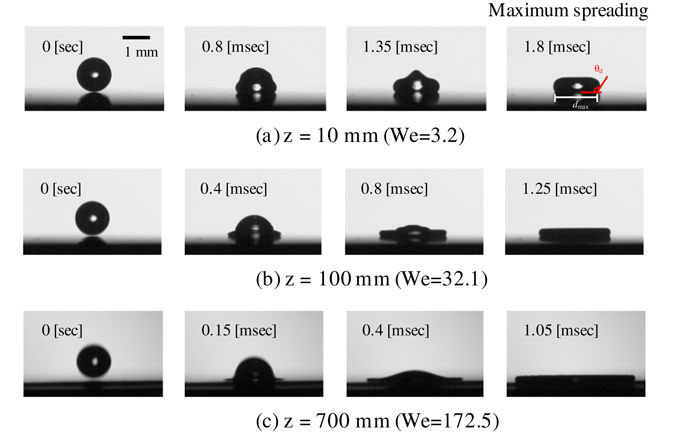固体表面に衝突した液滴の濡れ拡がりに関する解析的考察
Analytical consideration of liquid droplet impingement on solid surfaces
2017年5月24日 Scientific Reports 7 : 2362 doi: 10.1038/s41598-017-02450-4

噴霧冷却や燃焼などを含む工業的応用では、固体表面に衝突した液滴の最大濡れ拡がり直径を予測することで、熱除去やエネルギー消費を定量的に見積もることができる。しかし、液滴の衝突挙動に関する実験的研究は数多いが、最大濡れ拡がり直径を予測する理論モデルには適用限界がある。今回我々は、接触線における水平方向と垂直方向の両方の付着エネルギーを考慮した、エネルギー保存に基づく液滴衝突の解析モデルを開発した。その理論は、我々の実験と広範囲のウェーバー数に亘る既存の実験データによって検証された。我々は、今回のモデルが、さまざまな固体表面上のマイクロメートルサイズの液滴からミリメートルサイズの液滴に及ぶさまざまなニュートン液体のβm(すなわち、初期の液滴直径で無次元化した最大拡がり直径)を予測でき、毛管領域と粘性領域の間の遷移を決定できることを実証した。さらに、多くの研究で観測されたさまざまなスケーリング則の理論的な関係も導かれている。
Corresponding Author
In industrial applications involving spray-cooling, combustion, and so on, prediction of the maximum spreading diameter of a droplet impinging on a solid surface permits a quantitative estimation of heat removal and energy consumption. However, although there are many experimental studies regarding droplet impingement behaviour, theoretical models have an applicability limit for predicting the maximum spreading diameter. In the present study, we have developed an analytical model for droplet impingement based on energy conservation that considers adhesion energy in both horizontal and vertical directions at the contact line. The theory is validated by our experiment and existing experimental data possessing a wide range of Weber numbers. We demonstrate that our model can predict βm (i.e., the maximum spreading diameter normalised in terms of initial droplet diameter) for various Newtonian liquids ranging from micro- to millimetre-sized droplets on different solid surfaces and can determine the transition between capillary and viscous regimes. Furthermore, theoretical relations for scaling laws observed by many researchers are derived.

